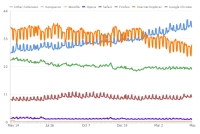Does your mobile phone provide better quality than a typical webcam? I'll test some virtual webcam software for mobile.
Does Google pass IE with WebRTC?
 It’s been years since any of us have seen the message “This site looks best when using Internet Explorer.” With the onslaught of new WebRTC applications, the message is likely to re-appear though with the word “Chrome” substituting for Explorer. The folks at Google will just be tickled pink to see all these little notification windows popping up. But what does this mean if you’re trying to develop a WebRTC application?
It’s been years since any of us have seen the message “This site looks best when using Internet Explorer.” With the onslaught of new WebRTC applications, the message is likely to re-appear though with the word “Chrome” substituting for Explorer. The folks at Google will just be tickled pink to see all these little notification windows popping up. But what does this mean if you’re trying to develop a WebRTC application?
On the face of it, Google Chrome has been been gaining share of the worldwide desktop. Here is some data from Getclicky (a highly popular site tracking service which I recommend). This data represents actual data from the 300 million actual page views that they track.
Internet Explorer, like a patient in cardiac arrest, appears to have an irregular heartbeat and the prognosis for the patient perhaps isn’t good. If one were to extrapolate the chart data, you might conclude that over time Internet Explorer would be rendered simply irrelevant. Clearly Chrome is doing well and easily has 40+% of the market and gaining. Super.
But that’s only half the story. Deeper demographics on browsers is a bit harder to get out. Since an IP address is relatively anonymous, various organizations have tried to determine just ‘who’ you are behind that IP adddress and the correlation between your selected browser and who you are, but it’s hard to figure out.
I am associated with a company offering a business service with an online presence and we attract about 8,000+ unique visitors per month (not large, but a decent representation). We use Getclicky and our demographics reflect a different story, namely that Internet Explorer visitors represent 28% of our page views, closely followed by Chrome at 27%, Firefox 20% and Safari 12% (side note, 10% of the remaining is from mobile). Roughly speaking Internet Explorer is at par with Chrome.
What we’ve found in customer conversation is that Internet Explorer users tend to be older. Or they’re corporate users, whose computers prohibit the installation of another browser. All of us have a favorite browser. But the short is many businesses still are using IE.
If I introduce a WebRTC app on my business site nearly 40% (IE and Safari) of those visiting won’t have immediate access to the application. On the face of it, not so good. The WebRTC team has created a plug-in called Google Frame that would allow Internet Explorer to utilize WebRTC. Right now it’s a bit of pain to test (YouTube video explaining). But even assuming it works reliably, it’s still a plug in. Something the user must download & install.
Of the 28% of Internet Explorer visitors to my site, what % will already have the plug-in? What % can’t install a plug-in due to enterprise restrictions? Finally, what % won’t bother? This looks like a quite of a gauntlet to be run. Or do I say screw it and simply denote “My site works best using Chrome” and pray users switch browsers (right). We all know what Google wishes for.
The challenge will be to create such compelling applications that the user will indeed switch browsers to afford themselves the experience. We all also hope that Microsoft switches flags and endorses WebRTC, leaving Apple out in the cold alone (a definite maybe). For now though, as an application developer, we should all be aware that while WebRTC offers some definite sweetness in terms of capabilities, there will be challenges on the road ahead.
